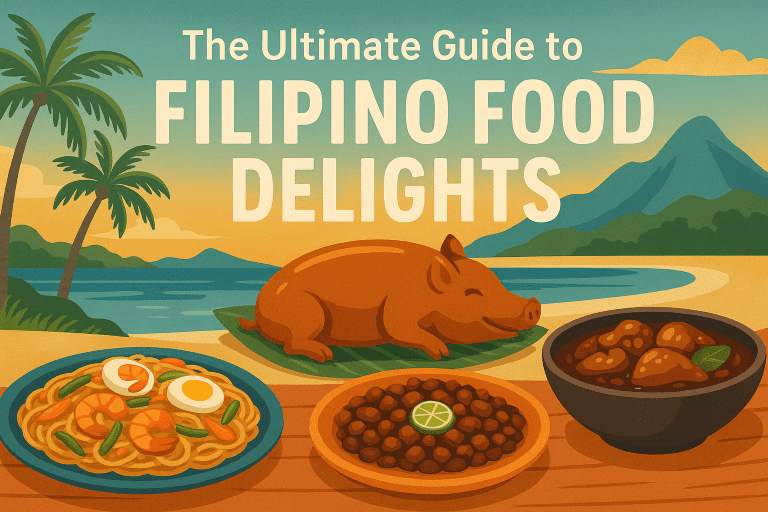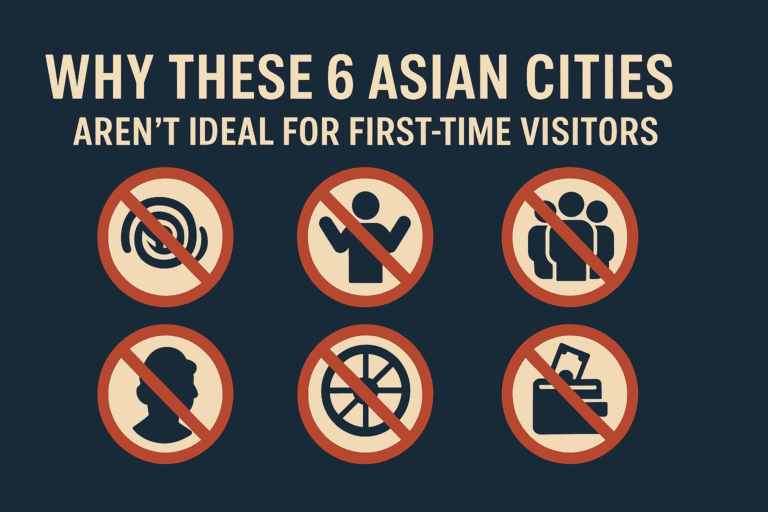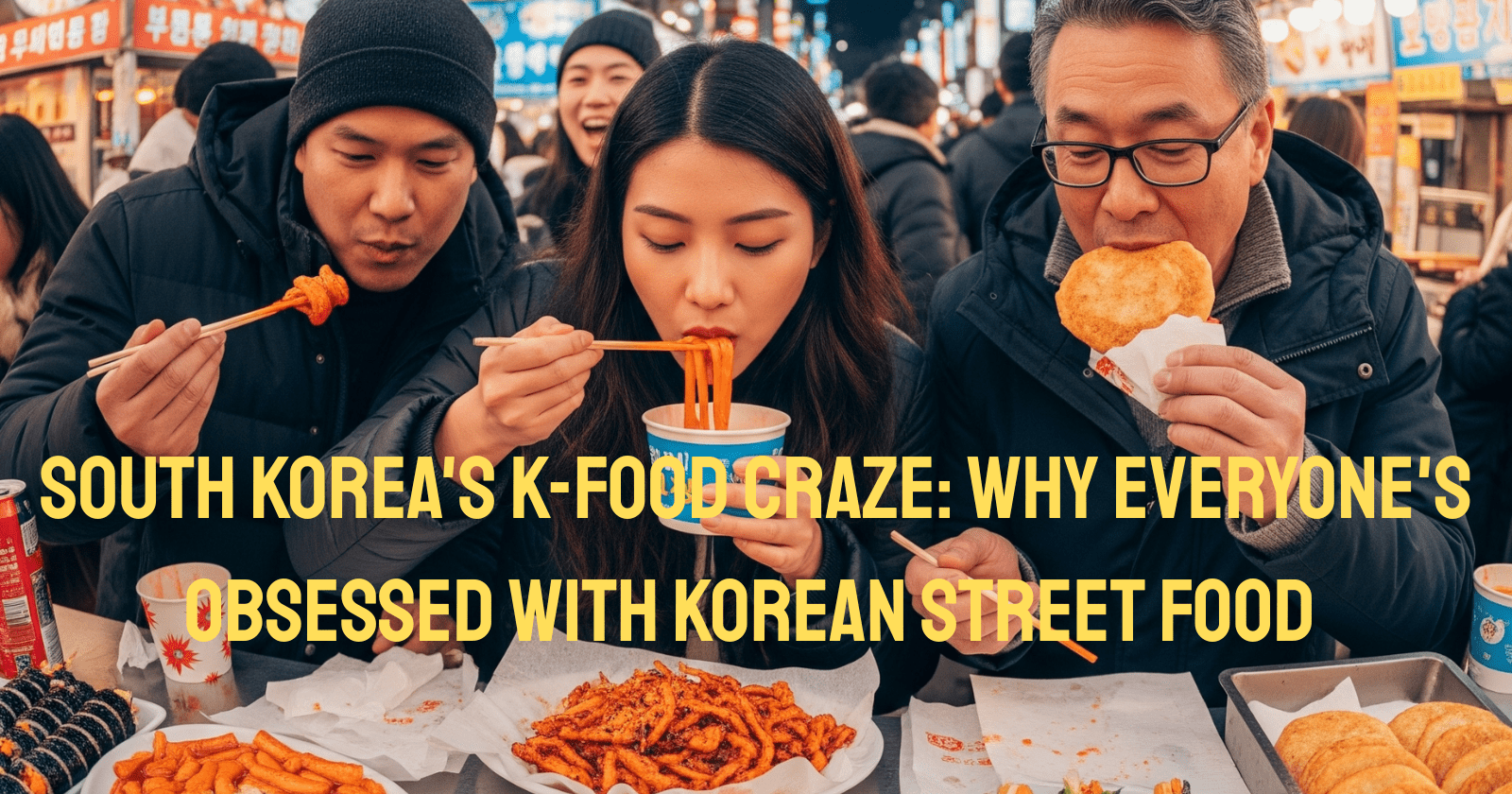
Wandering through the vibrant, bustling streets of South Korea, particularly in sprawling cities like Seoul, you are immediately enveloped by an intoxicating symphony of sights, sounds, and most powerfully, smells. For a seasoned traveler who thrives on finding the pulse of a place through its markets and local eats, the ubiquity of vendors preparing sizzling, steaming, and often vibrantly coloured dishes is an undeniable draw. It’s here, amidst the lively energy, that we find the heart of South Korea’s K-Food Craze Korean Street Food.
This isn’t just about grabbing a quick bite; it’s a profound immersion into the nation’s culinary soul, a sensory experience that transcends mere sustenance. The global fascination with Korean culture, propelled by K-Pop, K-Dramas, and K-Beauty, has undoubtedly brought traditional Korean cuisine into the international spotlight. But arguably, the most accessible and democratic facet of this culinary wave is its street food scene. Why has this informal style of dining captivated so many worldwide? It’s a question worth exploring, delving past the immediate deliciousness to understand the deeper cultural currents that give Korean street food its enduring appeal.
The Deep Roots of Korean Street Food Culture
To truly appreciate the phenomenon of Korean street food today, we must first understand its historical and social context. Street food, or pojangmacha (literally ‘covered wagon’ or ‘tent bar’) and noryangjin (referring to the type of stall often found near markets), has long been woven into the fabric of Korean life. Its origins are not purely culinary; they are deeply entwined with necessity and community.
Historically, life in Korea, especially during periods of rapid urbanization and economic development, was incredibly fast-paced. People needed quick, affordable, and convenient meals or snacks while commuting, working long hours, or simply navigating their busy days. Street food vendors provided exactly that – fueling the workforce and offering a brief moment of respite. The portable nature of the stalls meant they could appear wherever people congregated: near markets, train stations, bus stops, and later, in entertainment districts.
Beyond convenience, these humble stalls served as vital social hubs. They were places where people from all walks of life could gather informally, share a simple meal or a drink (often soju or makgeolli), and unwind after a long day. This aspect reflects a broader theme in Korean culture – the importance of communal eating and social bonding over food. While formal dining has its place, the pojangmacha offered a relaxed, unpretentious environment where hierarchies could momentarily blur, and genuine connection could flourish. They were sanctuaries of shared experience, providing warmth (literally and figuratively) on cold evenings.
Exploring the Delicious World: Eight Korean Street Food Staples
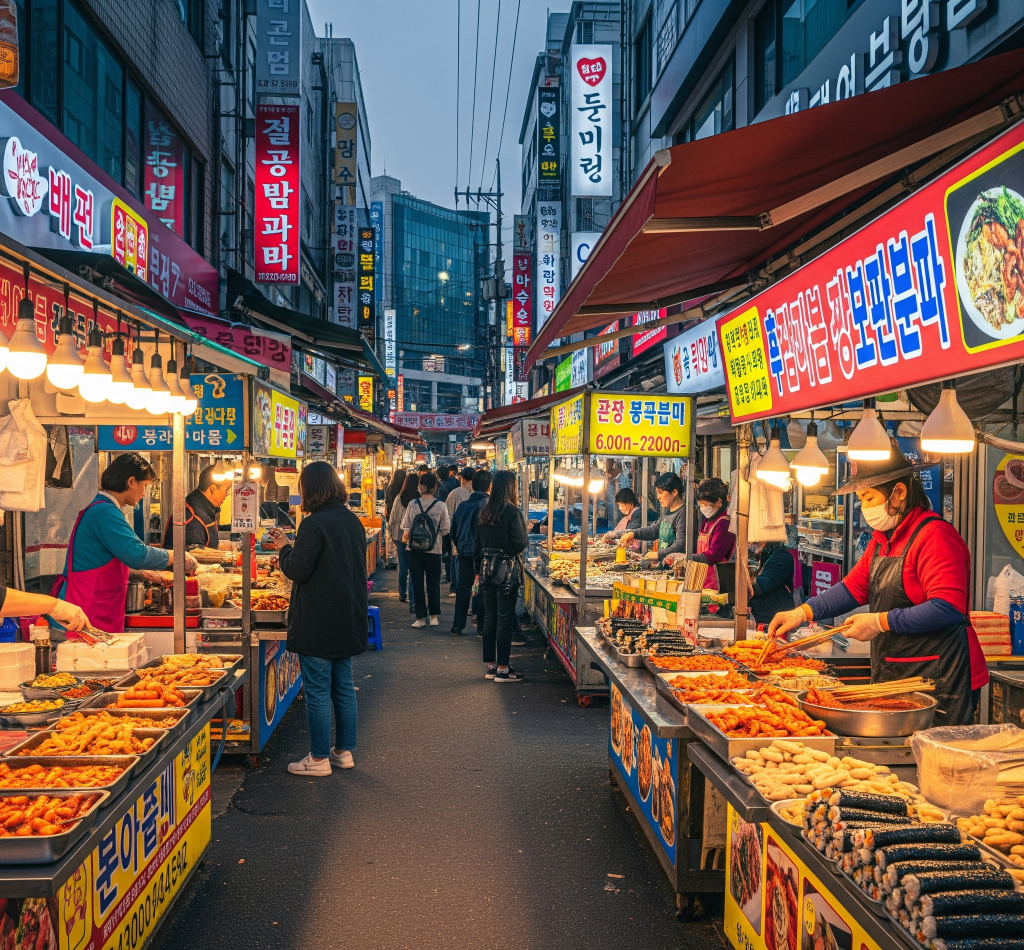
For a traveler, the joy of Korean street food lies in the exploration, the vibrant stalls, the friendly (sometimes brisk!) interactions, and the sheer variety of tastes and textures available. It’s about engaging directly with the culinary process, watching vendors expertly prepare dishes right before your eyes. Here are eight quintessential Korean street foods that capture the essence of this scene, along with tips on where a keen market explorer might find them:
1. Tteokbokki (Spicy Rice Cakes): Perhaps the most iconic Korean street food, tteokbokki consists of chewy cylindrical rice cakes (tteok) simmered in a fiery red sauce made from gochujang (Korean chili paste), gochugaru (chili powder), anchovy broth, and often fish cakes (eomuk or oden), cabbage, and scallions. The flavour is a complex balance of spicy, sweet, and savory, with a satisfying chewiness from the rice cakes. As a traveler navigating the streets, you’ll find tteokbokki stalls virtually everywhere people gather – train stations, school areas, and especially in major street food hubs like Myeongdong or the alleys of Jongno in Seoul. Look for the large, flat pans of bubbling red sauce; the vibrant colour is unmistakable.
2. Eomuk/Oden (Fish Cake Skewers): Another staple, especially popular during colder months, eomuk consists of various shapes and types of fish cakes served on skewers in a warm, savory broth, often flavored with radishes and kelp. It’s comforting, slightly chewy, and the warm broth is served in paper cups, perfect for warming your hands. Eomuk stalls are ubiquitous and often found right next to tteokbokki vendors. Major markets like Gwangjang Market or Namdaemun Market will have plenty, but you’ll also spot them on almost any busy street corner, offering a quick, warm bite.
3. Sundae (Korean Blood Sausage): Don’t be put off by the name! Korean sundae is a unique and flavorful sausage made by steaming pig or cow intestines stuffed with a mixture of cellophane noodles, barley, glutinous rice, and pig’s blood. It’s usually served sliced, often with a side of salt mixed with chili powder for dipping. Some vendors also serve it with liver and lung slices. Sundae has a distinct, savory, slightly earthy taste and a soft, slightly chewy texture. Finding sundae is easiest in traditional markets like Gwangjang Market, often near stalls selling tteokbokki or gimbap, but specialized sundae alleyways also exist in certain neighborhoods.
4. Gimbap (Seaweed Rice Rolls): Often described as Korea’s answer to sushi rolls, gimbap is a rice roll wrapped in dried seaweed (gim) and filled with a variety of ingredients like seasoned vegetables (carrots, spinach, pickled radish), egg omelette, imitation crab meat, ham, tuna, or bulgogi. It’s typically sliced into bite-sized rounds. Gimbap is the ultimate portable food – easy to eat on the go and available everywhere from convenience stores to dedicated street food stalls. You’ll find vendors assembling fresh rolls in most street food areas, offering a lighter, fresher option.
5. Hotteok (Sweet Filled Pancakes): A beloved sweet treat, especially in winter, hotteok is a small, pan-fried pancake made from a yeasted dough, typically filled with a sweet mixture of brown sugar, cinnamon, honey, and crushed nuts or seeds. It’s fried until golden brown and slightly crispy on the outside, with a molten, gooey interior. The contrast between the warm, sweet filling and the chewy dough is simply delightful. Hotteok vendors are common in areas with foot traffic during colder months, like Myeongdong or near traditional markets. Look for flat griddles and the sweet aroma wafting through the air.
6. Bungeoppang (Fish-Shaped Pastry): These charming fish-shaped pastries are made from a simple batter cooked in a mold and traditionally filled with sweet red bean paste (anko). Modern variations might include custard, chocolate, or even savory fillings. The exterior is slightly crispy, while the inside is soft and warm. Bungeoppang is another winter favorite, sold from small stalls or carts equipped with the distinctive fish-shaped grills. Finding them often feels like a treasure hunt, but they frequently pop up near subway stations, bus stops, or university areas when the weather turns cold.
7. Twigim (Korean Fried Snacks): Twigim refers to various ingredients coated in a light batter and deep-fried until crispy. Common items include shrimp, squid, various vegetables (like sweet potato slices, perilla leaves, or peppers), and even hard-boiled eggs. Twigim is often served with a dipping sauce, usually a soy-based mixture with vinegar and chili, or it can be dipped into tteokbokki sauce. Street food vendors will display an array of these golden, crispy delights. You can often pick and choose the ones you want. Markets like Gwangjang are famous for their extensive twigim selections, often served alongside tteokbokki and sundae, creating a popular combination called ‘tteok-soon-twigim’.
8. Kkochi (Skewers): This broad category encompasses various ingredients served on skewers. Popular options include chicken skewers (dak-kkochi) grilled with a sweet and savory sauce, often spicy; sausage skewers; fish cake skewers (though often listed separately as eomuk); and even vegetable skewers. Kkochi offers a convenient, portable way to enjoy different flavors. Grilled skewers are easy to spot by the smoke and aroma they produce. They are widely available in street food areas and are a great option for trying different sauces and marinades.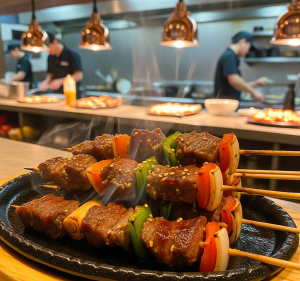
The K-Food Craze in Modern Life and Navigating Respectfully
The presence of street food in modern South Korea extends far beyond simple convenience. It remains a vital part of the social landscape, adapting to contemporary tastes while retaining its cultural significance. Street food districts like Myeongdong in Seoul have become major tourist attractions, celebrated not only for their food but for the lively atmosphere they create. For locals, while quick lunch spots and cafes are prevalent, street food still offers that spontaneous, informal option for a snack, a cheap meal, or a late-night bite after drinks (often referred to as anju when paired with alcohol). It embodies a sense of nostalgia for some and a casual, accessible dining choice for all.
The global K-Food craze has undoubtedly amplified interest in these street eats. People exposed to Korean culture through media are eager to taste the dishes they see characters enjoying. This increased demand has led to more vendors, greater variety, and unfortunately, in some highly touristy areas, potentially higher prices or a slightly less “local” feel. However, venturing a little off the main drag, perhaps into a local market like Tongin Market (famous for its ‘coin system’ lunchboxes) or exploring neighborhoods outside the central tourist zones, can still provide a very authentic experience.
As travelers, engaging with street food culture respectfully is key to a positive experience. While the atmosphere is casual, remember you are interacting with people making their livelihood. Simple courtesies go a long way. Often, you pay before receiving your food, especially for quick items like skewers or hotteok. Have smaller denominations of Korean Won ready. While some vendors in tourist areas might speak basic English or have signs with pictures, pointing is perfectly acceptable if language is a barrier. Don’t linger too long after finishing, especially if others are waiting. These are busy spots, and efficiency is appreciated. We learn that even in the most informal settings, a foundational respect for the process and the people is essential, a lesson that resonates whether you’re exploring Vietnam’s hidden food scene or finding your way through Sapporo’s night life.
Consider this scenario: You approach a popular tteokbokki stall in a crowded market. The vendor is swiftly serving multiple customers. Instead of trying to get their immediate attention or pointing frantically, you patiently observe the queue, if there is one, or wait for a brief moment when the vendor makes eye contact or finishes with the current order. You then politely indicate what you’d like, offer payment promptly, and step aside slightly to enjoy your steaming hot tteokbokki, making space for the next person. This small act shows awareness and respect for the vendor’s busy workflow and the shared public space.
Street food is also a reflection of Korean culinary innovation. While staples remain, vendors constantly experiment, offering fusion items or new takes on classics. This dynamism keeps the scene fresh and exciting. The increasing global awareness of Korean cuisine, partly fueled by its street food’s popularity, even contributes to broader economic impacts and South Korea’s position as a cultural powerhouse. As the New York Times noted in 2022, Korean food’s global moment is more than a trend; it reflects a complex interplay of culture, history, and adaptability.
For budget-conscious travelers like myself, street food is also a godsend. It allows you to sample a wide variety of dishes without committing to a full restaurant meal or price. You can curate your own tasting menu as you wander, picking and choosing based on what looks and smells most appealing. This flexibility is part of the adventure, much like finding cities where digital nomads thrive on a budget.
While major tourist areas are convenient for finding a concentration of vendors, don’t hesitate to explore smaller markets or street corners in residential or business districts. These spots often cater more to local tastes and might offer slightly different variations or specialties. Engaging with vendors through simple gestures and a polite smile, even with a language barrier, creates a positive interaction. It reinforces that your interest comes from a place of genuine curiosity and appreciation for their craft and culture. This openness to spontaneous interactions is key to unlocking local experiences, whether you’re finding the best Asian cities for first-time travelers or navigating the hustle of Asian airports.
Conclusion: More Than Just a Meal
The K-Food craze, particularly its street food component, is far more than a fleeting trend; it is a dynamic expression of South Korean culture, history, and social life. It provides a tangible connection to the nation’s past while remaining vibrantly relevant in its present. For the traveler, exploring the street food scene is an unparalleled opportunity to engage directly with Korean everyday life, to taste the flavors that have comforted and sustained generations, and to participate, however briefly, in a communal experience.
The K-Food craze is a beautiful example of how culture can travel, connect, and build bridges. Through the simple, universal act of sharing food, we find common ground and foster empathy across borders. So, next time you find yourself wandering a Korean street, follow your nose, be brave, and dive into the incredible world of Korean street food. It’s an adventure for your taste buds and a lesson in cultural appreciation, all in one delicious package.






